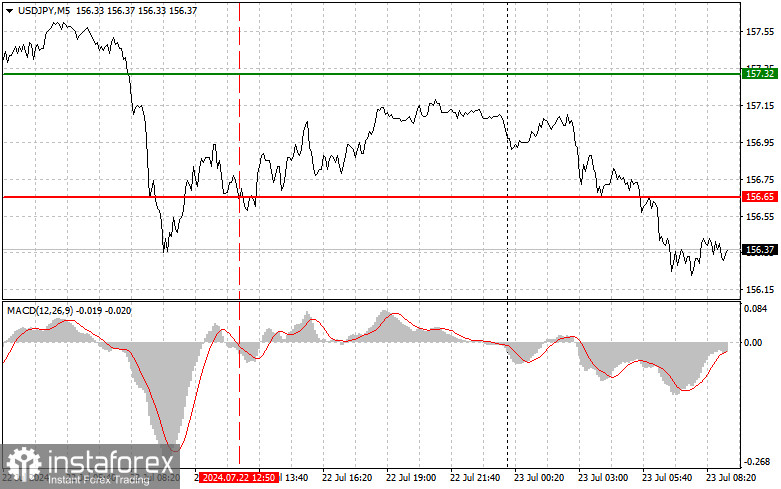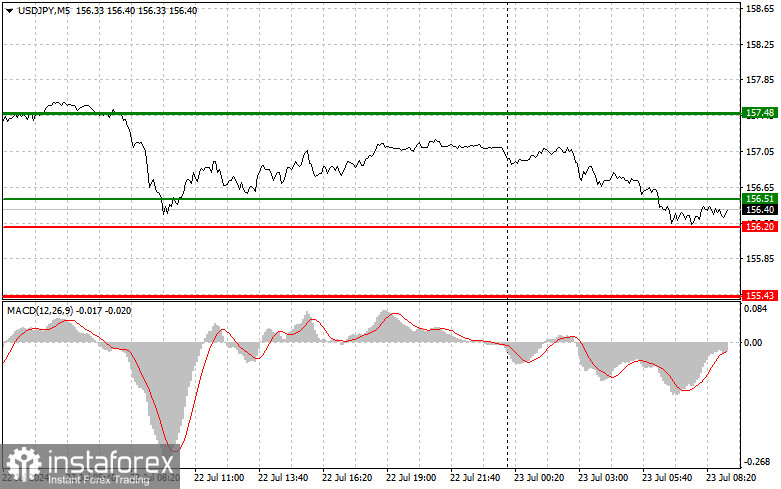Overview of trading and tips on USD/JPY
The price test of 156.65 occurred when the MACD indicator started falling from the zero mark, confirming the correct entry point to sell the dollar. However, the chart shows that the pair did not make another significant move, leading to a loss. USD/JPY was under pressure in today's Asian session, which was reasonably expected given the ongoing market pressure. As I mentioned in yesterday's review, even major hedge funds are starting to reconsider their strategies on the currency pair. There are no updates today, so I expect the pair to recover after hitting a new weekly low, similar to yesterday. As for the intraday strategy, I will rely more on implementing scenarios No. 1 and 2.

Buy signals
Scenario No. 1. Today, I plan to buy USD/JPY when the price reaches the entry point around 156.51 plotted by the green line on the chart, aiming for growth to 157.48 plotted by the thicker green line on the chart. Around 157.48, I'm going to exit long positions and open short ones in the opposite direction, expecting a movement of 30-35 pips in the opposite direction from that level. You can count on the pair to rise today, but it's better to act as low as possible. Before buying, make sure that the MACD indicator is above the zero mark and is just starting to rise from it.
Scenario No. 2. I also plan to buy USD/JPY today in case of two consecutive tests of 156.20 when the MACD indicator is in the oversold area. This will limit the pair's downward potential and lead to a reverse market upturn. One can expect growth to the opposite levels of 156.51 and 157.48.
Sell signals
Scenario No. 1. I plan to sell USD/JPY today only after testing the level of 156.20 plotted by the red line on the chart, which will lead to a rapid decline in the price. The key target for sellers will be 155.43, where I am going to exit short positions and immediately open long ones in the opposite direction, expecting a movement of 20-25 pips in the opposite direction from that level. Pressure on USD/JPY may return at any moment, especially in case the price fails to consolidate around the intraday high. Before selling, make sure that the MACD indicator is below the zero mark and is just starting to decline from it.
Scenario No. 2. I also plan to sell USD/JPY today in case of two consecutive price tests at 157.48 when the MACD indicator is in the overbought area. This will limit the pair's upward potential and lead to a reverse market downturn. One can expect a decline to the opposite levels 156.20 and 155.43.

What's on the chart:
The thin green line is the entry price at which you can buy the trading instrument.
The thick green line is the estimated price where you can set Take-Profit (TP) or manually close positions, as further growth above this level is unlikely.
The thin red line is the entry price at which you can sell the trading instrument.
The thick red line is the price where you can set Take-Profit (TP) or manually close positions, as further decline below this level is unlikely.
MACD line: it is important to be guided by overbought and oversold areas when entering the market
Important: Novice traders in the forex market need to be very careful when making decisions to enter the market. It is best to stay out of the market before important fundamental reports are released to avoid getting caught in sharp price fluctuations. If you decide to trade during news releases, always place stop orders to minimize losses. Without setting stop orders, you can quickly lose your entire deposit, especially if you don't use money management and trade in large volumes.
And remember, for successful trading, it is necessary to have a clear trading plan, similar to the one I presented above. Spontaneously making trading decisions based on the current market situation is inherently a losing strategy for an intraday trader.
 English
English 
 Русский
Русский Bahasa Indonesia
Bahasa Indonesia Bahasa Malay
Bahasa Malay ไทย
ไทย Español
Español Deutsch
Deutsch Български
Български Français
Français Tiếng Việt
Tiếng Việt 中文
中文 বাংলা
বাংলা हिन्दी
हिन्दी Čeština
Čeština Українська
Українська Română
Română

